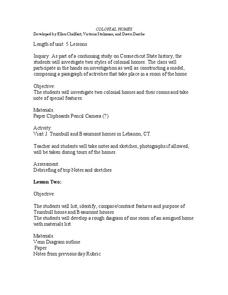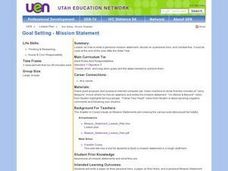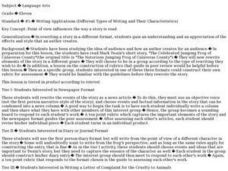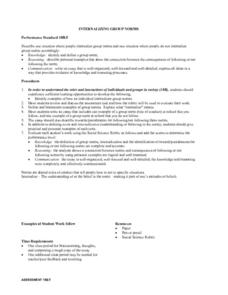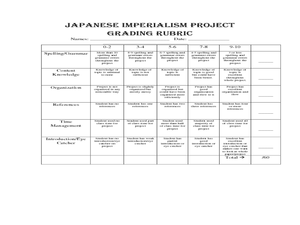Curated OER
Personal Timeline
Seventh graders review the stages of the writing process. In this writing process lesson, 7th graders review the writing process steps by creating a personal timeline. Students complete graphic organizers for the lesson and present their...
Curated OER
Blueprint Writing
Eighth graders write a narrative composition about funny incidents in their home lives. In this narrative writing lesson, 8th graders define what a blueprint is and draw one for their home. Students write about events that happened in...
Curated OER
Reading the Biography
Students explore the lives of famous Americans. In this biography lesson plan, students read biographies about famous Americans and keep reading journals as they read about setting, main events, and character sketches.
Curated OER
Colonial Homes
Learners tour colonial homes in Connecticut and compare their features. For this colonial homes lesson, students create a diorama after returning from a field trip to homes. Learners use their observations and comparisons to...
Curated OER
Coming to America
Students present tableaus showing scenes from The Memory Coat, a book about immigration. In this tableau lesson plan, students examine the cover of the book and make predictions about what is happening and who the people are. They...
Curated OER
100 Years...100 Movies
Students watch one of the top 100 movies to view, research critical reviews and then, write their own reviews.
Curated OER
Substance Use and Its Effect on Behavior
Third graders engage in a lesson which causes them to think about substance use and afford them an opportunity to use their resistence skills for avoiding potentially harmful situations.
Curated OER
STORY MAPPING: THE HUNDRED DRESSES
Learners illustrate and paraphrase each chapter of The Hundred Dresses, creating a graphic organizer through the use of story mapping. After students have completed their story maps, ask for a few volunteers to present theirs to the class.
Curated OER
Goal Setting -- Mission Statements
Learners read examples of mission statements related to goal setting. Individually, they research accomplishments of their hero and how they overcame fear. To end the activity, they write their own mission statement on how they plan to...
Curated OER
Writing Applications: Different Types of Writing and Their Characteristics
Twelfth graders rewrite a story in a different format to understand the effects of the author's style. In this writing style lesson, 12th graders read Mark Twain's "The Celebrated Jumping Frog of Calaveras County" and rewrite the...
Curated OER
Social Studies: The United Nations
Students examine the purposes of the United Nations and write brief paragraphs about them. Included is an explanation of why the United States is a member and the benefits it enjoys from membership. Students discuss the importance of...
Curated OER
Internalizing Group Norms
Students consider how to internalize group norms. They descirbe a situation where people internalize group norms and a situation where people do not internalize group norms. They brainstorm examples of group norms and define...
Curated OER
Obituary
Students complete a worksheet on a historical figure of their choice. Using this information, they write an appropriate obituary of the person in German or other foreign language. They present the obituary to the class to end the lesson.
Curated OER
Fit For Life Presentations
Students use the internet to compare and contrast the diet, nutrition and fitness of a major language group and the United States. As a class, they are introduced to the vocabulary in the language related to health and fitness and share...
Curated OER
Listening for Leschi: Voices from the Past
Learners interview a family other than their own to learn about oral history. In this oral history lesson plan, students also create a newspaper article about Leschi and pretend they interviewed him back in the past.
Curated OER
The Japanese Empire: The Beginning
Ninth graders explore empires by researching Japan's history. In this Japanese research lesson, 9th graders discuss the history of Japan and the elements of World War II that caused Japan to become an enemy of the United States. Students...
Curated OER
Picture This!
First graders watch the teacher model how to draw pictures and write words in a First, Next, Then, Last - 4 block graphic organizer. They write and draw in their own 4 block papers.
Curated OER
Rhetorical Devices
Eleventh graders consider rhetorical devices in speeches and then make an informed selection of effective rhetorical devices for a controversial topic presentation. Students present their findings using presentation software.
Curated OER
Writing a Narrative
Sixth graders read the short story "Eleven". They write a narrative composition focusing on the use of voice. Students use a computer to create a pre-writing graphic organizer and type their final draft.
Curated OER
Rhetorical Devices
Twelfth graders identify and analyze examples of rhetorical devices as valid or invalid inferences. For this text analysis lesson, 12th graders research a controversial topic in teams and identify rhetorical devices for the topic....
Curated OER
How To: Friendly Letter Writing
Second graders investigate the proper mechanics of a letter by writing to fictional characters. For this friendly letter lesson, 2nd graders read the book Stars in the Darkness, analyzing the story and characters with classmates....
Curated OER
Letter Writing from a Different Perspective
Third graders write a letter from one character to another in a story they are reading. In this writing lesson plan, 3rd graders demonstrate their understanding of perspective.
Curated OER
Now You're Speaking My Language; Deciphering the Symbols of Early Civilizations
Learners explore early attempts at written language. In this early civilizations lesson, students investigate first attempts at written communication. Among the civilizations covered are Mayan, Greek, and Egyptian.
Curated OER
ENDOWING SUPPORT ELEMENTS
Students demonstrate how an actor might engage sensate reaction using 3 sets of stage props. They imagine and use as many sense reactions as they can to make the props become endowed with a reality. They use one table and chair to...





